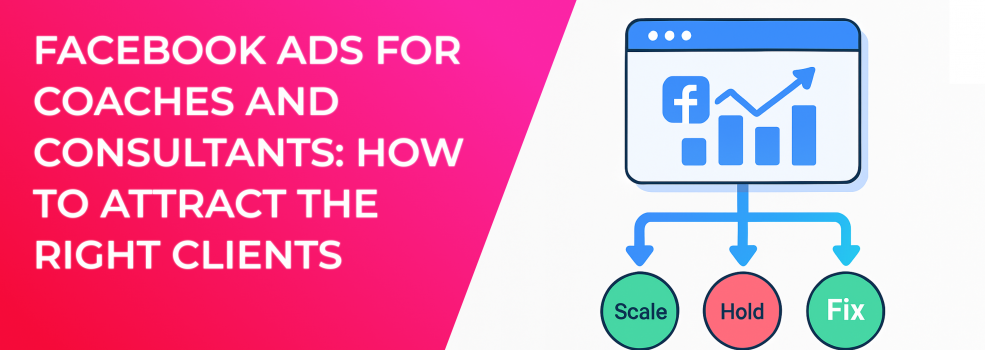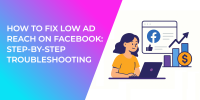Coaching and consulting succeed on authority and trust, yet even the strongest program stalls if the right prospects never see it. Among all social platforms, Facebook (now Meta) still offers the most versatile mix of custom audience building, ad audience targeting, and campaign budget optimization tools. This deep-dive playbook shows you exactly how to use those features without wasting budget to fill your calendar with high-value clients.
Clarify Your Ideal Client Before You Spend a Cent
Every euro you pour into Ads Manager should be guided by a single paragraph that answers:
-
Demographics – age, gender, location, language
-
Psychographics – ambitions, pain points, buying triggers
-
Behaviors – pages they follow, masterminds they join, tools they use
Without this snapshot even the smartest algorithm can’t rescue a campaign. Keep it open beside you while configuring Facebook ad targeting options so each click aligns with the humans you want to serve.
Build Foundation Audiences First
A. Warm Lists (Custom Audiences)
Upload your email subscribers, past buyers, or webinar attendees — how to make custom audience on Facebook is one of the most-searched queries because it works. Meta matches those records to user profiles so you can greet warm leads the moment they open their feed.
B. Pixel & Engagement Pools
Install the Meta Pixel (plus the Conversions API). If you’re unsure, search “create pixel on Facebook” for Meta’s own guide. Anyone who visits key pages or watches 25% of a video becomes eligible for FB retargeting ads — a pivotal tactic in any Facebook ad optimization plan.
C. Lookalike Expansion
When a warm list passes ≈ 1,000 members, spin up a 1 % lookalike. Meta’s AI finds users who “look” like your best buyers, letting you scale reach while protecting lead quality.
Layer Smart Interest & Location Targeting to Refine Reach
After the foundation is set, tell Meta who else deserves to see your offer. Most coaches either dump every vague interest (“entrepreneurship”) into one mega-ad-set or skip this stage entirely. Instead, treat interest and geo-targeting ads like the fine-tuning dial on a radio: they remove static so only the people most likely to book a call hear your message.
Pro Tip: Add an Exclude rule for “Past Purchasers” when promoting a new-client offer; you’ll avoid paying twice for the same eyeballs and keep ad frequency in check.
Turning Data Into Daily Action
Week 1: Launch separate ad sets for each layer above, using identical creatives.
Days 4 – 7: Monitor cost-per-lead (CPL) and booking rate in Ads Manager.
Week 2: Shift 60% of budget to the top performer; duplicate it with fresh creative to fight fatigue.
Monthly: Re-sync your email list, create fresh 1 – 3% lookalikes, and test new Facebook interest targeting ideas so the algorithm never runs dry.
With this disciplined routine you’re not guessing, you’re running a data-driven client-attraction engine.
Craft Magnetic Creatives That Speak to Coaching Pain Points
Before you touch Canva or fire up your camera, pause and plan. Images and copy aren’t art projects, they’re the bridge between a scrolling stranger and a scheduled strategy call. Ask yourself:
What tangible outcome can you visually show in three seconds?
Which single objection keeps prospects stuck, and how can your image contradict it?
Which emotional trigger — pride, relief, status — matters most to your niche?
Answer those and you’re already ahead of 90% of the Ad Library clutter. The next step is to choose the right Facebook ads keywords for your headline and primary text so the algorithm instantly knows who should see the ad. Lean on high-intent phrases like “Facebook ads tips” or “Facebook advertising best practices” when you want to underline authority.
Three “Can’t-Skip” Creative Formats
Lead with transformation: show the “before vs. after” in a split image or quick-cut video. A fitness mindset coach might show a cluttered desk morphing into a booked-solid calendar.
Narrative testimonials: short video clips or quote cards beat generic praise. Pull a three-sentence story that ends in a metric — “5 new retainer clients in 30 days” — to satisfy both humans and the Facebook ads advice crowd hunting proof.
Thumb-stopping hooks: open with a question that mirrors their internal dialogue — “Tired of selling time for money?” hits harder than “Book a call.” Pair it with bright contrast or a subtle motion graphic to win the first second of attention.
Extra Creative Optimization Tips
Keep text under 20 % of the image area to avoid throttling — yes, the old rule is “gone,” but Meta still favors uncluttered visuals.
Use color contrast that matches your brand palette but still pops against both light and dark-mode feeds.
Heat-map test thumbnails in organic posts first; your highest click-through posts often become your best-performing ads.
Save every successful creative inside a “Top Ads – Q3” folder so you can revive or repurpose assets when launching fresh campaign budget optimization tests.
Great messaging lowers CPL more than any tweak to ad audience targeting — think story first, settings second.
Launch Campaigns the Algorithm Loves
Advantage Campaign Budget (ACB)
Toggle advantage campaign budget — Meta’s evolution of campaign budget optimization Facebook specialists rave about. It automatically funnels spend toward the ad sets delivering the best CPL or ROAS.
ACB lets Meta move money to the winners without manual tweaks.Starting Point
Daily budget: $20 – $50
Bid type: Leads or Conversions (not Traffic)
Placements: Advantage+ Placements (let Meta test feeds, reels, stories)
Respect the Learning Phase
Each ad set needs about 50 conversion events per week to exit learning limited Facebook ads status. Avoid constant edits; let data accumulate first. If you do get stuck in Learning Limited, consolidate ad sets or raise the budget slightly.
Measure, Iterate, Optimize
Successful coaches treat Ads Manager like a coaching client: they listen, diagnose, and adjust continuously. Facebook ads advice forums brim with hacks, but the pros follow a simple, repeatable scorecard that keeps them laser-focused on numbers that prove the ads are attracting qualified prospects, not just cheap clicks.
Primary metrics: CPL, application-to-call rate, program-enrollment ROAS
Secondary: cost-per-initiate-checkout, click-through rate
Once you know what to watch, bake a rhythm into your calendar so optimization never slips:
Weekly: pause bottom-quartile ads, duplicate top performers with fresh creatives — classic “facebook ads tips” that still work.
Monthly: audit Events Manager, check pixel diagnostics, and compare Facebook advertising analytics to see which funnel stage leaks.
This cadence turns reactive tinkering into proactive, data-driven improvement — key to mastering Facebook ad optimization long-term.
When to Scale and When to Hold
Ambitious coaches often reach for the budget slider the moment a campaign turns green, but scaling too early can nuke ROAS overnight. The goal is to grow without losing the targeting precision and message-market match you worked so hard to achieve. Treat these rules like traffic lights — green means accelerate, yellow means assess, red means pivot:
Use clear signals to know when to push budget or pause for tweaks.
Scale when CPL is at least 20% below target for two consecutive weeks and ad frequency is below 2.
Hold if CPL creeps up, creatives fatigue, or audience overlap exceeds 25%.
Fix by rotating creatives, excluding recent engagers, or expanding to a 3% lookalike to inject fresh but still relevant eyeballs.
Put It All Together with LeadEnforce
DIY optimization works, but it’s time-consuming. That’s why many consultants use LeadEnforce to automate the grunt work while they coach. Think of the platform as a force multiplier for everything you just learned:
Bulk “target customers on Facebook” extraction from LinkedIn or niche FB groups — ideal for feeding new lookalike seeds every month.
One-click sync of fresh custom audiences into every Meta ads campaign so lists never go stale.
By handling the heavy lifting, LeadEnforce lets you stay in your zone of genius — coaching — while your acquisition engine hums quietly in the background.
Final Thoughts
Client acquisition isn’t about shouting louder; it’s about whispering to the right people. By combining precise Facebook ad targeting options, warm custom audiences on Facebook, disciplined advantage campaign budget scaling, and tools like LeadEnforce, you’ll consistently generate discovery calls with prospects who are ready to invest — first in themselves, then in you. Start small, learn fast, optimize smart, and watch your calendar (and impact) fill up.

